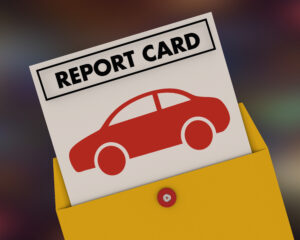Offering a view into the future of auto insurance, the leader of a mobility data and analytics firm said during a recent interview that he foresees a time when drivers will know their driving scores and proudly share them.
“I believe that in the future, people will be taking their great driving score and they’ll be shopping it around to insurance companies,” Gary Hallgren, president of Arity, told Carrier Management, drawing comparisons to the availability of credit scores.
Arity, a B2B company with a mission of making transportation safer, smarter and more economical, does not currently provide scores it develops based on the frequency of distracted driving, speeding, sudden breaking or time of travel directly to customers. Instead, it uses driving behavior data to power services promised by third-party apps like Life360, a family driving network, offering crash detection, and GasBuddy, offering personalized features to optimize fuel consumption and map out efficient driving routes based on past driving behavior. Arity also delivers driving data insights and actual driving scores, derived from a customer’s actual driving data, to insurance companies under certain conditions.
But until a recent article published in The New York Times, few drivers ever heard of Arity and had no idea what a driving score was. The article, “Is Your Driving Being Secretly Scored?” (subscription required), details the decision of a Life360 user who canceled her annual subscription when she found out that Arity, a company she was unfamiliar with, had access to her driving behavior data, which Arity could potentially share with insurers. The article was one of a series of Times articles written by technology reporter Kasmir Hill, investigating transparency issues in the collection of driving data from connected cars and smartphone apps.
In fact, as the Times article reports, an insurer needs to get direct consent from customers to access driving behavior data connected to third-party apps for insurance pricing purposes—whether the app’s mobility features are powered by Arity or a similar company. While Hallgren readily concedes that Arity is not a brand that consumers would know, he believes that once they understand that consent structure, and they are educated on the individual and societal benefits, they will welcome the insights unearthed by driving data. It will not only help them to appreciate why they’re paying the prices they are for car insurance when they participate in telematics programs but also highlight unsafe behaviors they engage in behind the wheel.
“I think having this thing is going to be a currency for consumers,” he said, referring to a driving score. “It will be good. In the meantime, while people are new to it,” it makes sense to Hallgren for everyone to “over-index on transparency [and] over-index on consumer education.”
Excerpts of our recent interview are set forth below.
Q: What is Arity and how does Arity obtain driving data?
Hallgren: Arity is a data and analytics company. We have a mission that is much broader than insurance—making transportation safer, smarter, more useful really is the goal. It all centers around driving data and trying to use it in a variety of ways to help customers, [for] things like crash detection or using data to help DOTs and government agencies to better understand dangerous intersections. All of those fit inside of the Arity mission.
As part of that, we want to get our technology embedded within mobile apps to understand how people are driving. So, that’s in insurance company apps and it’s also in apps where we partner with others to deliver services to them. Those services can be collision detection. They could be how to drive more fuel efficiently. Or how parents can understand driving behaviors of their kids as they’re growing up…
We think we’re quite unique in this space in that we believe we process more data than anybody, [perhaps more] than the rest of the industry combined…We also have rich access to claims data, which allows us to truly understand risky driving. I like to say that we have a unique way to identify and quantify risky driving because we have access to claims data through [Arity’s owner], the Allstate Corporation. But the data that we collect is largely outside the Allstate corporation. We have a pretty good perspective of how people drive in the general public and then also how people drive inside of usage-based insurance programs…
Q: Is Arity only getting data through insurance apps and third-party apps, or does data come from connected cars as well?
Hallgren: We do have relationships with connected car companies. [At Arity], the connected car data is small today. Everyone expects it to be more in the future. Today the mobile data is more predominant…But both can be very helpful to make transportation better.
Really the goal of this is to understand how people are driving and then to be able to help them to change it. And I think people are ready for it. More than half of people surveyed are comfortable sharing their driving data. (Source: Arity report, “Data in action: Solving the driving safety crisis“)
Related article: Has Driving Behavior Changed?
Some [articles] that have shown [up] in the media use inflammatory words. But when you have a real conversation with any individual and explain [some of the] risky driving behaviors, and how you know they’re risky, and [then ask], ‘Shouldn’t these somehow be factored into an assessment of how safe you are?’ they agree. It just makes sense.
So, we feel very good that the future is going to be driving scores or using this data to create this understanding of driving—and that ultimately consumers will see this as more transparent, more controllable, just more logical in ways to understand the riskiness.
We just think it’s the future, and I don’t think any of these articles have changed that.
Q: Arity is a B2B company, not directly dealing with consumers. How do Arity’s partners get consent from consumers to access driving data?
Hallgren: We focus on apps where it’s very logical…Whether it’s GasBuddy or Life360, these companies need to have access to this data to deliver the services that consumers want to have.
Our partners get consent to collect location data to enable the driving services they offer in their app—like crash detection or fuel efficiency. Every partner is responsible for its own consent process and notices, which is unique and tailored to fit how that partner interacts with its customers. When it comes to insurance companies needing access to this data, there’s a separate consent process where customers choose to share their driving data with their insurer for a quote.
Q: How do people agree that the driving data can be used for insurance pricing purposes?
Hallgren: Carriers get consent to use data as they go through their normal flows, and this has been, I think, evolving as the industry has grown over time. There’s a consent structure that the carriers have. They’re all regulated entities. When we think about what happened to create the perception of how this was working, I’m not inside of those companies, but my belief is that everybody followed all the appropriate laws and transparency requirements. I think what has changed and is evolving are people’s perceptions.
So, we’ve said in the past that just because you’re compliant with the regulation or you’re compliant with the law, I don’t think we’re doing enough necessarily to really communicate with customers…
There’s an understanding that when you sign up for a quote with an insurance company, that if you have speeding tickets, you’re giving the insurance company rights to look to see if you had speeding tickets. That’s where I believe this will be as well—that you’re going to have a driving score. But right now, people aren’t used to having a driving score or aren’t used to having this data being used.
I think that it would be good for the industry to be even that much more transparent during this time of adoption where people get more comfortable with it. And I believe that in the future, people will be taking their great driving score and they’ll be shopping it around to insurance companies in the same way that people do that today with mortgages or their credit score in other ways. I think having this thing is going to be a currency for consumers. It will be good.
In the meantime, while people are new to it, I think it would be good to over-index on transparency. And I think it would be good to over-index on consumer education.
Q: I can get my credit score and understand a bit about what’s a high and low score. Does it make sense as a step in the future to have consumers actually have access to their driving score and give them understanding of what it means?
Hallgren: It does. And I think that is what will happen in the aftermath of the New York Times articles. I have seen different blogs written by insurance veterans about just that. People need to understand the concept—what it means.
Here’s a common misunderstanding: “I slammed on my brakes, and I didn’t hit the dog crossing the street, and then my insurance rate went up.”
No, it didn’t. But there’s that perception that these individual events are what’s causing swings in scores, and it just isn’t the case.
So, there is education that the industry should be doing—describing more about how these factors are used, and why they’re used. Then people will start to understand them better, and we can get away from some of these [reports] that cause alarm in consumers. It just comes back to transparency and education.
Q: Have you connected with insurers about the idea of allowing consumers like me to access my driving score directly? Who would I contact?
Hallgren: The way that it works is [there are] companies that are like Arity; you can think of Arity like a consumer reporting agency. [And] other companies in the industry are also fulfilling a similar type of role…
When the insurers ask for driving data, I don’t know what others do, but what we provide to them—with the consumer’s consent—is a summary of the driving characteristics. That’s what they get. So, the idea that every time that you went to the mall or to the golf course, it is embedded in that data, at least from us, that’s not the data that’s passed. It’s behavioral characteristics about the driving data.
What a consumer can then do if they’ve had this data used is, they, much like they would with the credit bureau, can [ask] what data was passed to the insurance company and receive a report on it. That structure exists today.
Where I think there’s room for growth is what you described earlier—[putting] more context around it. So, in the future, we, and I’m guessing others, will have more contextual information so that the average consumer can really understand what that means. That’s where I would like to see the industry go.
Q: So, do you actually foresee a time when a consumer will say “I want my Arity score, my Verisk score and my LexisNexis score” and compare them the same way we do today with credit scores?
Hallgren: I think so. Exactly…I really believe that. I think they [the scores] will be mildly different and they’ll be roughly the same. Today, if you look at your FICO Score 8 versus FICO Score 9 versus your VantageScore, they’re all built on some similar characteristics, but they’re all used differently.
When I think of driving scores of the future, that’s the way I picture it. They’ll have a lot of similar characteristics, [but they will] have maybe some unique characteristics potentially. And then the carriers will model them mildly differently. But ultimately if you’re on the phone all the time while you’re driving and you’re speeding a huge percentage of the time, everyone’s going to be putting you in a risky bucket. And if you’re doing none of those things, you’re going to be in a lower bucket. There’s probably going to be differentiation in the middle.
Q: Let’s say I sign up for a third-party app today, like Life360, and Arity is getting the driving data. But when I’m asked if an insurance company can use my data to price insurance, I say no. I want to opt out of that. Does Arity still develop a driving score based on the data? Or does Arity just use that data in an aggregate way to understand behaviors and accident correlations?
Hallgren: We don’t know your email address or phone number or anything about you inside of the business that supports the app providers in delivering those [services]. If that app is showing a driving score, then we compute it. We will be processing that information because we’re using that to serve that app customer. Once an insurance company requests that data, then we move it into a different part of our business, and it falls inside of the FCRA [Fair Credit Reporting Act] side of things. So, it’s very much a structured process in how we do it to ensure that the data is used in the right way.
Q: Someone else I interviewed suggested that the process of consent to use driving data is very clear when you download an insurance company app or a third-party app but may be less clear for connected cars. Do you have the same perception?
Hallgren: My worldview is the insurance apps make sense when you download, and you get consent for doing that because it’s happening at the time that you’re performing the action. And what we advocate is that it becomes far more crystal clear when somebody is going through a quote process or engaging with their insurance company that this data is being used.
I don’t believe the right time to ask for consent to use data for an insurance quote [that will happen] in the future is while you’re in the middle of buying a car. To me, that doesn’t make sense because at that point in time you’re not [always] thinking about buying insurance. So, maybe you just instinctively say no, in which case you’re not going to avail yourself of [future] savings. Or if you do say yes back then, then when it [eventually] is used, [if] they don’t ask you again, you’re going to forget you did it.
So, my belief on consent is [that] it should be very close to that exact time that it is being used…

Q: When I bought a new car a few years ago, my salesman automatically signed me up to share data. I didn’t see the process. I think a lot of people have that experience. How could it be better?
Hallgren: It’s interesting, when I went through the process recently and the person had me download the app, I looked through the questions, and personally I thought they were crystal clear. It was a very good experience. I knew that data was being collected. I knew that it was being used for emergencies and for diagnostics, and then there was an insurance piece in there, too. But still, my belief is even if I said yes there knowingly, I should say yes again when I’m going through the quote process…
When I’m buying a car, I’m thinking about getting out of this dealership and getting on with my day and getting into my car. I’m not thinking about how I want to protect myself with car insurance in the future.
Q: One of the New York Times articles is titled, “Is Your Driving Being Secretly Scored?” While the article describes some of the good aspects of pricing insurance based on driving, people reading such headlines may still get a negative perception. Talk more about the education piece. What can the insurance industry be doing better to change that?
Hallgren: Even some of the more extreme articles [said] driver scores might actually be a good thing, and they might actually be a more transparent and a more fair way to [price insurance]. They came around to a pretty balanced view…
(Editor’s Note: The Times article quotes a consultant and a consumer advocate who highlight the benefits of pricing insurance based on driving behavior rather than socioeconomic factors like credit score, employment or education level, and even factors like territory and age—particularly, for example, for a cautious 20-something male in a busy city who is safer than a middle-aged female road-rager in the suburbs.)
I think [with] more transparency, more consent and more education, there will be more people that avail themselves to these services. And our belief is that 60 percent of people will actually save—broadly stay the same or see a pretty meaningful reduction [in insurance premium]. The reductions could be huge if you do these broadly simple behaviors—I’m not going to speed, I’m not going to drive aggressively and I’m not going to use my phone—and if you then avail yourself to these [UBI] programs.
There’s really a lot of goodness in this for you when you do understand that if I am using my phone every mile that I’m driving, chances are: 1) it’s not needed; 2) it’s not safe; 3) it’s against the law. Maybe if I don’t do this, I can also save some money…
The insurance industry is on the right side of this issue. More education and more success stories would be great.
Q: Has Arity changed anything, or have you nudged any of your partners to change anything? There are really good articles on the Arity website in the blog section. But consumers probably don’t go there. How do you get that good information out? What should your partners be doing better?
Hallgren: I’m not sure that we’re ever going to be the right people that will do the end-consumer descriptions, but I think we will help them in some of their communications with their customers. And who knows, maybe we should be doing more directly because we really have such a unique understanding of the data.
As far as how we’re changing, it’s a very fluid environment. This industry was very much kind of a research-y kind of thing for years. Now it’s getting more mainstream. And I think public perception is there on using it, but the actual how—I think [there] needs to be more perception around that.
We continue to change and evolve and want to stay certainly in line with all of the regulations and laws. But there are…opportunities to be even more explicit than what a law or regulation would say—just because we think it’s the right thing to do to stay ahead of this consumer perception as opposed to saying, well, legally this is what we need to do. That’s enough. I think we could do more sometimes…
Q: Your website has a privacy statement that is very detailed, but it’s 15 pages long. People aren’t likely to read through that. But you’re probably legally bound to say all that.
Hallgren: That’s what we talked about earlier—the idea that these are the four or five things that really matter. These are how you can tell if you’re risky or if you’re not. Just understanding those…Then, the 15 pages probably mean a lot less…
I really believe that five years or 10 years down the road that people are going to have the score. It’s going to be as commonplace as what you would think. They’re going to be proud of it. Those that see that I’m maybe paying more because I use the phone all the time when I drive, even though I thought I was safe enough, will make educated choices.
Q: In order to change the behaviors, the drivers really have to be interested in the process and clued into what the data says.
Hallgren: The neat thing with what you’re doing by educating this audience is that the education does need to be there from the carriers. They need to understand it. It is such a new thing. But there is no doubt in the research and the data that one of the ways to get more accurate with pricing—so that the right people are being priced accordingly—is through data like this.
It’s going to be an evolution of how people use it…The more that you can help educate the industry to understand it, then consumers [will get it]. There isn’t a person you meet on the street—there’s no one I’ve ever talked to that when you explain how this works and why it’s better [doesn’t say], ‘I guess you’re right.’ It just makes sense.
Q: What else would you like to tell the insurance carrier audience?
Hallgren: Probably the biggest thing is that they will be surprised that the more transparent they are, the more people will understand and will work with them and appreciate that. The benefits of using this data [are] so good for consumers and for those that are performing these risky behaviors. You can educate them to change those behaviors.
The industry is in a great spot to be able to make a lot of impact in people’s lives, and then also be able to really just become more accurate in what they’re doing. So, more transparency, more education and lean into this technology. It’s not going away and it’s only going to be better.
Related article: Has Driving Behavior Changed?





















 Future of Auto Insurance: OEM-Insurer Ties Could Boost Profits, Loyalty
Future of Auto Insurance: OEM-Insurer Ties Could Boost Profits, Loyalty  Allstate: How Can You Save on Auto Insurance?
Allstate: How Can You Save on Auto Insurance?  Revisiting California’s Wildfires: A Personal Journey
Revisiting California’s Wildfires: A Personal Journey  Progressive: Policies Grow Faster Than Workforce
Progressive: Policies Grow Faster Than Workforce 












